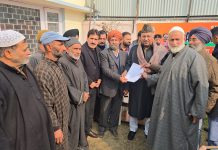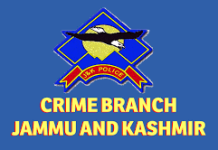Kashmir, October 10, 2022: Minister of Civil Aviation, Jyotiraditya M. Scindia on Monday said that a civil enclave will be built in Jammu at a cost of Rs 861 crores and the Srinagar’s present terminal will be expanded three times from 20,000 square meters to 60,000 square meters at a cost of Rs 1500 crores.
Scindia said this while inaugurating 4th Heli-India Summit 2022 with the theme ‘Helicopters for last Mile Connectivity’ at Sher-i-Kashmir International Conference Centre, Srinagar, in presence of Lieutenant Governor of the Union Territory of Jammu and Kashmir, Manoj Sinha.
During the summit, Scindia, as per an official handout, said that the decrease in VAT on Aviation Turbine Fuel (ATF) from 26.5 percent to one percent by the J&K government has set a new dawn for air connectivity in the Union territory with 360 percent increase in refueling, thus increasing the air connectivity to Jammu and Kashmir.
Praising PM Narendra Modi for what he said bringing a revolution in the Civil Aviation sector in India from 2014 onwards, Scindia said that from 1947 to 2014, the country had only 74 airports, but now the number has increased to 141, with 67 added in last seven years which shows the pace of progress in the Civil Aviation sector.
The government, he said, was committed to increase the number to above 200 in the next few years, Scindia added.
He said that the Civil Aviation has now become the need of the hour not only for India but for humankind across the world as it always brings with it two important multipliers, the economic multiplier and the employment multiplier.
The sector has huge impact with economic multiplier of 3.1 and employment multiplier of 6, the Minister informed. Therefore, the Civil Aviation across the world today forms a very important cog of the wheel of economic development, the Minister added.
During the summit, Scindia said that helicopters have multifarious roles, providing urban connectivity which is no more an elitist prerogative in India but is based on PM Narendra Modi’s vision ‘Sab Ude, Sab Jude’. The other roles of helicopter service has been the emergency medical services and disaster management during floods, rescue operations etc., the Minister informed. Jammu & Kashmir has set an example of the best use of helicopter service when it erected transmission lines and towers using heli-cranes (sky cranes) on the Peer Panjal mountain range, the Minister added.
Scindia further said that Civil Aviation Ministry not only organizes summits but also monitors the progress of ‘Sankalps’ taken from one summit to another.
During the 3rd Heli-India Summit at Dehradun, the eight Sankalps taken like providing Heli-Sewa Portal, Heli-Disha, Helicopter Accelerator Cell, doing away with the landing & parking charges for helicopter service, creation of specific helicopter corridors, helipads to be given priority while framing DPR for all new highways, upgradation of Juhu airbase to accommodate night operations etc. were taken to their logical end.
HeliSewa portal is fully online and being used by all operators for obtaining landing permissions to helipads, and it also is creating a database of helipads in the country.
HeliDisha, the guidance material on helicopter operations for State administration has been distributed to 780 districts. The Helicopter Accelerator Cell is fully active in resolving helicopter issues and the advisory group of industry representatives is helping identify problems areas.
“We have waived off landing and parking charges for helicopters at airports and we have started helicopter sensitization training of ATC officers for speedier helicopter traffic handling. Three helicopter corridors from Mumbai-Pune, Ahmedabad-Gandhinagar, and Shamshabad-Begumpet have been created and new IFR corridors are being planned. Working with MoRTH, we have been able to allot helipad spaces from the design stage for all future expressways and major highways so that it can be used for the evacuation of accident victims. And we have already commenced work on the upgradation of Juhu helibase which is the largest in the country, to accommodate night operations and helicopter IFR routes using GAGAN,” he added.
The Minister informed that today the guidelines on Fractional Ownership Model have been released to help grow the non-scheduled operations. “While our scheduled operations are on the fast track and we have increased the fleet size from 400 aeroplanes in 2013 to more than 700 in 2021-22, through these guidelines, we should be able to spur growth in the non-scheduled fleet too,” he said.
Fractional ownership, he added, will lower the barrier on the cost of acquisition of helicopters and aeroplanes through pooled capital by multiple owners.
“This will allow companies and individuals to minimise their capital outflow by sharing the purchase cost, reducing their exposure to risks and making it financially easier to run a NSOP business. Fractional Ownership Model has the potential to energize the NSOP segment by democratising ownership of aircraft and it can be a key driver to boost the number of aircraft existing in the NSOP industry. The helicopter industry should be recognised for its social service. It is not a transportation vehicle but a transformation tool, it can be used not only for economic development but could also to transform lives.”, he added.
Scindia said that they have also decided to incubate a HEMS pilot called Project Sanjeevani by deploying a helicopter in the next few weeks to provide emergency medical services at AIIMS Rishikesh.
The helicopter will be based at the hospital at 20 min notice and will have a service cover to an area of 150 km radius. It is the intention of the Govt to expand medical outreach and access to trauma care services to a wider population base across the country using the speed advantage and mobility of helicopters. We will use the learnings from Project Sanjeevani to explore the viability of the concept, its benefits, and the attendant risks and later articulate a national policy on HEMS before committing larger resources.
Lieutenant Governor of Jammu and Kashmir, Manoj Sinha, who was special guest during the summit said that the decision taken by the J&K UT government of decreasing VAT on Aviation Turbine Fuel (ATF) from 26.5 percent to one percent has increased air connectivity to J&K, with more than 100 flights being operated from J&K now.
Sinha further said that J&K has seen a new dawn of development after the abrogation of Article 370, with increased road connectivity, air connectivity and development of railways infrastructure with work on Rupees one lakh crore worth projects underway in J&K.
In terms of railway connectivity, Jammu and Kashmir will be connected to Kanyakumari by the next year, Sinha informed.
Besides other dignitaries, the summit was attended by Secretary, Ministry of Civil Aviation, Rajiv Bansal, Principal Secretary, Department of Civil Aviation, J&K, Alok Kumar, Additional Secretary, Ministry of Civil Aviation, Usha Padhee and Remi Maillard, Chairman FICCI Civil Aviation Committee and President and MD, Airbus India.



